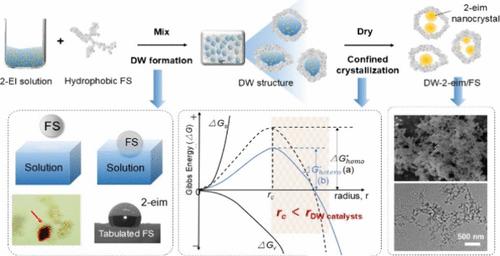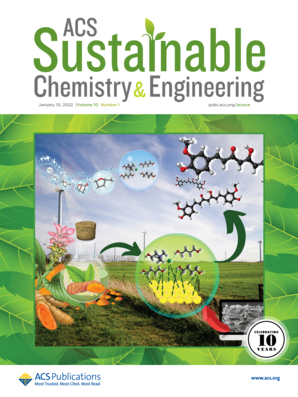Dry-Water-System Confined Fabrication of Nanocuring Catalysts for Superior Low-Cure Powder Coating
IF 7.1
1区 化学
Q1 CHEMISTRY, MULTIDISCIPLINARY
引用次数: 0
Abstract
Curing catalysts can accelerate cross-linking reactions but often deteriorate surface performance due to heterogeneous catalysis, which can be resolved by improved homogeneous dispersion of nanoscale catalysts and thus uniform catalysis of resin cross-linking reaction. Nonetheless, nanosizing solidified catalysts, typically organic small molecular crystals, presents challenges using conventional top-down and bottom-up methodologies. Herein, we present a straightforward approach to preparing nanocuring catalysts by leveraging the dry-water structure and obtaining high-performance low-temperature curing coatings. The stable dry-water structure, with microscale catalyst solution droplets surrounded with hydrophobic fumed silica, was formed. Confinement of fumed silica effectively limits the size of the organic catalyst crystals on the nanoscale by ensuring the low 2-eim content in the separated compartment. Coatings incorporating the obtained catalyst, cured at a lower temperature of 170 °C for 15 min, exhibit mechanical strength and chemical resistance compared to standard powder coatings cured at 190 °C for 15 min. Furthermore, with the improved uniform catalysis brought from the nanocatalyst, the low-temperature curing coatings demonstrate excellent surface performance, maintaining gloss levels comparable to the original powder coating film. This study delves into the mechanism of the dry-water structure, offering a facile approach for fabricating nanoscale curing catalysts and achieving high-quality surfaces in powder coating applications.

干水系统密闭制造纳米固化催化剂,实现卓越的低固化粉末涂料性能
固化催化剂可以加速交联反应,但往往会因异构催化而导致表面性能下降,而改进纳米级催化剂的均匀分散,从而均匀催化树脂交联反应,则可以解决这一问题。尽管如此,使用传统的自上而下和自下而上的方法对固化催化剂(通常是有机小分子晶体)进行纳米化仍是一项挑战。在此,我们提出了一种利用干水结构制备纳米固化催化剂并获得高性能低温固化涂层的直接方法。通过疏水性气相法二氧化硅包围微尺度催化剂溶液液滴,形成了稳定的干-水结构。气相法二氧化硅的封闭作用可有效限制纳米级有机催化剂晶体的尺寸,确保分离区中的 2-eim 含量较低。与在 190 °C 下固化 15 分钟的标准粉末涂料相比,在 170 °C 下固化 15 分钟的较低温度下固化的含有所获催化剂的涂料具有更高的机械强度和耐化学性。此外,由于纳米催化剂的均匀催化作用得到了改善,低温固化涂料的表面性能极佳,可保持与原始粉末涂料膜相当的光泽度。这项研究深入探讨了干水结构的机理,为制造纳米级固化催化剂和在粉末涂料应用中实现高质量表面提供了一种简便的方法。
本文章由计算机程序翻译,如有差异,请以英文原文为准。
求助全文
约1分钟内获得全文
求助全文
来源期刊

ACS Sustainable Chemistry & Engineering
CHEMISTRY, MULTIDISCIPLINARY-ENGINEERING, CHEMICAL
CiteScore
13.80
自引率
4.80%
发文量
1470
审稿时长
1.7 months
期刊介绍:
ACS Sustainable Chemistry & Engineering is a prestigious weekly peer-reviewed scientific journal published by the American Chemical Society. Dedicated to advancing the principles of green chemistry and green engineering, it covers a wide array of research topics including green chemistry, green engineering, biomass, alternative energy, and life cycle assessment.
The journal welcomes submissions in various formats, including Letters, Articles, Features, and Perspectives (Reviews), that address the challenges of sustainability in the chemical enterprise and contribute to the advancement of sustainable practices. Join us in shaping the future of sustainable chemistry and engineering.
 求助内容:
求助内容: 应助结果提醒方式:
应助结果提醒方式:


